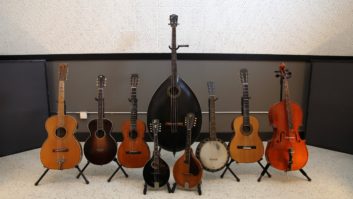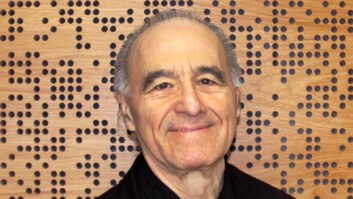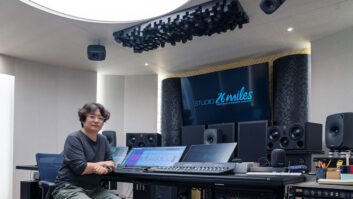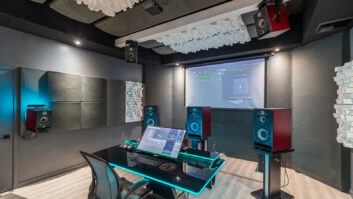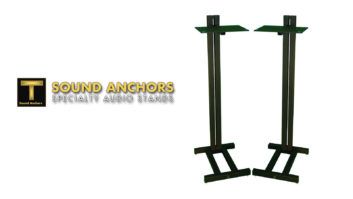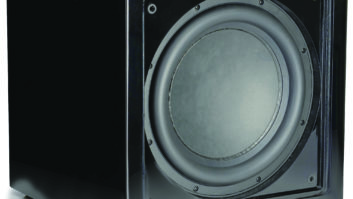Many studio listening environments today depend upon near-field or midfield monitors. And many veteran recording engineers make the mistake of placing their favorite near-fields on the space above the meter bridge of the console. But unless the studio owner has considered the boundary interference and placed the console accordingly, the engineer may be in for a long night.
It’s not enough to orient the speakers at the appropriate distance from the listener and from each other; the orientation of the speakers and listener from the boundaries of the room are also crucial to critical listening. This is because nondirectional low-frequency energy wraps around the back side of the speakers and returns from the front part of the room to the listener at a later arrival time than direct energy, causing both constructive and destructive (boosting or canceling) deviation in the frequency response at the listening position. This effect, combined with the modal response of the room, creates the response at the listener position. The idea is to situate the speakers and listener where the least amount of deviation will occur.
Finding these positions in real time is possible but cumbersome; it can be achieved by placing either the speaker or microphone in a stationary position and moving the other component in small (about 6-inch) increments while running pink noise through the speaker and routing the microphone to a real-time analyzer. Many locations must be observed before the most linear low-frequency response can be determined.
Enter RPG Diffusor Systems’ Room Optimizer software. This product is said to be the first Windows 95 program that automatically and simultaneously optimizes speaker-boundary and modal coupling to minimize this acoustical distortion. Room Optimizer does the dirty work at the speed of a computer processor. Whether configuring for stereo, 5.1 or some other setup, Room Optimizer software not only provides assistance in the placement of studio monitors but also provides a graphical display about what is occurring during the process of searching for the optimum speaker and listener position.
HOW IT WORKS
Room Optimizer combines geometrical and wave acoustics as part of the process of arriving at the desired speaker placement. Geometrical acoustics is the study of the more specular reflecting characteristics of sound; analysis combines ray tracing and image source methods. Similar to reflecting light off of a mirror, ray tracing follows the ray (wave) off the surface it strikes at the same angle of impact. After several reflections, this energy is diminished to below the hearing threshold. The image source method replicates a mirror of the original source equidistant to the perpendicular dimension from the source to the reflecting plane. Whereas ray tracing is more like a laser, the image source is similar to a flashlight or an expanding cone effect.
Wave acoustics characterizes the way distances between perfectly reflecting boundaries dictate the tonic frequencies and, thus, the harmonics of such frequencies in a given enclosure. The relationship between these roots and harmonics defines an enclosure’s modal response. Through mathematical formulations combining geometric and wave acoustic modeling, Room Optimizer emulates the impulse response of the room repeatedly as the position of the speaker and listener are continually relocated, until minimum deviation is achieved at the listener position. The speaker boundary response, which is the first or short-time response, and the modal or longtime response are considered in the final optimization.
IN USE
Room Optimizer walks the user through the set up of the speaker configuration, room dimensions, and three-dimensional limitations on speaker and listener placement. Once the configuration is established, the analysis process begins. While the program searches for ideal placement, the user can view:
* Data (values and position coordinates);
* Room (the changing locations of the speakers and listener with plain view, side and front elevation);
* Spectra (graphic information relating to the “best,” “worst” and “current” speaker boundary response and the modal response);
* Wizard (default search configurations);
* Configuration (described above);
* GRP Data (the location and recommendation for treatment of reflecting areas); and
* Error (graphical display of the progress of the error, which continually attempts to exceed itself).
FIELD RESULTS
All of this theory is great, but does it apply in the real world? To satisfy my own skepticism, I set up a rectangular room for testing. I used a 15-inch subwoofer with response to the mid-20Hz range. The test rig was SIA’s SMAART Pro analysis software and a B&K 4007 test microphone.
My first test was to run Room Optimizer and then position the mic and speaker according to the locations it specified. I then ran the SMAART Pro program to see how the response of Room Optimizer compared to that of the SMAART Pro. The response matched up remarkably. The SMAART Pro graph was ever so slightly different, because the boundaries of the room were not perfect reflectors; but the differences were basically insignificant.
So the math worked, but did it find the best location? I searched the room manually and found a flatter response. I beat the computer! Or did I? Oops-I had limited the search area in the Configuration window so the program could not search the entire room. When I freed the computer, it found a spot very close to mine with at least as flat a response in a fraction of the time, with much less effort.
A subwoofer can sure be heavy. The program kept re-proving and improving its findings, while I lost my breath competing with it. I much prefer having a beer while these virtual ghosts move my 80-pound subwoofer for me on the computer screen.
The results of the testing to this point were very impressive. I decided to introduce a bit of treatment into the otherwise naked room. I put lightweight free-standing devices in the corners to settle down a bit of the LF. The response changed; there was some shift in the affected frequencies. As you introduce people, furniture, equipment, acoustical treatment, etc., the response of the room changes, and thus the optimum speaker/listener position may also change.
While real acoustic measurement of a room is crucial, Room Optimizer is of great assistance in finding a solid starting-and in some cases, finishing-point. The majority of the rectangular room measurements I study agree with the positioning recommended by Room Optimizer, even after equipment and treatments have been added to the space. The more variables you bring into the room, the more it is likely to change, but the beauty of the Room Optimizer is that even in those cases this program gets you quite close as a starting point, so configuration becomes a tweak instead of a tear-down.
SUMMARY
Retailing at $99.99, RPG’s Room Optimizer is a highly useful tool for acoustically orienting a listening environment. As a professional studio designer/ acoustician, I often find myself running this program. I am waiting for the next generation that will consider irregular shapes, treatment, furniture, etc., but in the meantime, here’s a program that has great value in the studio world.
RPG Diffusor Systems, 6512-C Commerce Drive, Upper Marlboro, MD 20774; 301/249-0044; fax 301/249-3912; www.rpginc.com.


